MySQL数据库基础:JSON函数各类操作一文详解
Posted 小二上酒8
tags:
篇首语:本文由小常识网(cha138.com)小编为大家整理,主要介绍了MySQL数据库基础:JSON函数各类操作一文详解相关的知识,希望对你有一定的参考价值。
前言
很多日常业务场景都会用到json文件作为数据存储起来,而mysql5.7以上就提供了存储json的支撑。往常存储json一般都保留在pg库或者是hive库里面,现在mysql有了支持的话基本业务都可以用mysql来实现。现在mysql8.x版本对json字符出处理已经做的非常完善了。现在就让我们来详细了解一下关于json数据数据类型mysql都有哪些函数能够对其进行操作。
该系列文章将按照这个脉络行文,此系列文章将被纳入我的专栏一文速学SQL各类数据库操作,基本覆盖到使用SQL处理日常业务以及常规的查询建库分析以及复杂操作方方面面的问题。从基础的建库建表逐步入门到处理各类数据库复杂操作,以及专业的SQL常用函数讲解都花费了大量时间和心思创作,如果大家有需要从事数据分析或者数据开发的朋友推荐订阅专栏,将在第一时间学习到最实用常用的知识。此篇博客篇幅较长,值得细读实践一番,我会将精华部分挑出细讲实践。博主会长期维护博文,有错误或者疑惑可以在评论区指出,感谢大家的支持。
一、JSON语法规则
首先我们还是先复习一遍json数据类型的语法规则,这在我的很多文章都有写到:
JSON是一个标记符的序列。这套标记符包含六个构造字符、字符串、数字和三个字面名。
JSON是一个序列化的对象或数组。
- 数据为 键 / 值 (name/value)对;
- 数据由逗号(,)分隔;
- 大括号保存对象(object);
- 方括号保存数组(Array);
值可以是对象、数组、数字、字符串或者三个字面值(false、null、true)中的一个。值中的字面值中的英文必须使用小写。
如:
“code”:“100”
对象由花括号括起来的逗号分割的成员构成,成员是字符串键和上文所述的值由逗号分割的键值对组成: {“code”:20,“type”:“mysql”}
数组是由方括号括起来的一组值构成: “datesource”:[
“code”:“20”, “type”:“mysql”,
“code”:“20”, “type”:“mysql”,
“code”:“20”, “type”:“mysql”
] 复习完毕之后我们再来对mysql处理json函数实验。
二、JSON函数
首先我们创建一个表来进行操作:
create TABLE json_test(
id int not null primary key auto_increment,
content json
);
复制代码
接下来,向test_json数据表中插入数据。
insert into json_test(content) values('"name":"fanstuck","age":23,"address":"province":"zhejiang","city":"hangzhou"')
复制代码
可以使用“->”和“->>”查询JSON数据中指定的内容。
SELECT content->'$.name' FROM json_test where id =1;
复制代码

1.JSON_CONTAINS(json_doc,value)函数
JSON_CONTAINS(json_doc,value)函数查询JSON类型的字段中是否包含value数据。如果包含则返回1,否则返回0。其中,json_doc为JSON类型的数据,value为要查找的数据。
SELECT JSON_CONTAINS(content, '"name":"fanstuck"') FROM json_test ;
复制代码

SELECT JSON_SEARCH(content ->> '$.address', 'all', 'nanchang') FROM json_test ;
复制代码

3.JSON_PRETTY(json_doc)函数
JSON_PRETTY(json_doc)函数以标准的格式显示JSON数据。
SELECT JSON_PRETTY(content) FROM json_test ;
复制代码

4.JSON_DEPTH(json_doc)函数
JSON_DEPTH(json_doc)函数返回JSON数据的最大深度。
SELECT JSON_DEPTH(content) FROM json_test;
复制代码
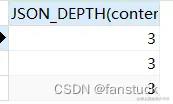
5.JSON_LENGTH(json_doc[,path])函数
JSON_LENGTH(json_doc[,path])函数返回JSON数据的长度。
SELECT JSON_LENGTH(content) FROM json_test;
复制代码

6.JSON_KEYS(json_doc[,path])函数
JSON_KEYS(json_doc[,path])函数返回JSON数据中顶层key组成的JSON数组。
SELECT JSON_KEYS(content) FROM json_test;
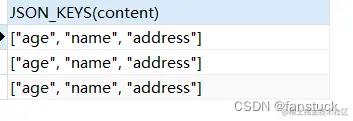
7. JSON_INSERT(json_doc,path,val[,path,val] …)函数
JSON_INSERT(json_doc,path,val[,path,val] …)函数用于向JSON数据中插入数据。
"age": 23, "name": "fanstuck", "address": "ip": "192.168.12.12", "city": "hangzhou", "province": "zhejiang"
复制代码

可以看到,JSON_INSERT()函数并没有更新数据表中的数据,只是修改了显示结果。
8.JSON_REMOVE(json_doc,path[,path] …)函数
JSON_REMOVE(json_doc,path[,path] …)函数用于移除JSON数据中指定key的数据。
SELECT JSON_REMOVE(content, '$.address.city') FROM json_test WHERE id = 2;
复制代码
9.JSON_REPLACE(json_doc,path,val[,path,val] …)函数
JSON_REPLACE(json_doc,path,val[,path,val] …)函数用于更新JSON数据中指定Key的数据。
SELECT JSON_REPLACE(content,'$.age',20) FROM json_test ;
复制代码

可以看到,JSON_REPLACE()函数并没有更新数据表中的数据,只是修改了显示结果。
10.JSON_SET(json_doc,path,val[,path,val] …)函数
JSON_SET(json_doc,path,val[,path,val] …)函数用于向JSON数据中插入数据。
SELECT JSON_SET(content, '$.address.street', 'xxx街道') FROM json_test WHERE id = 1;
复制代码

11.JSON_TYPE(json_val)函数
JSON_TYPE(json_val)函数用于返回JSON数据的JSON类型,MySQL中支持的JSON类型除了可以是MySQL中的数据类型外,还可以是OBJECT和ARRAY类型,其中OBJECT表示JSON对象,ARRAY表示JSON数组。
SELECT JSON_TYPE(content) FROM json_test ;
复制代码
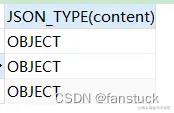
12. JSON_VALID(value)函数
JSON_VALID(value)函数用于判断value的值是否是有效的JSON数据,如果是,则返回1,否则返回0,如果value的值为NULL,则返回NULL。
SELECT JSON_VALID('"name":"binghe"'), JSON_VALID('name'), JSON_VALID(NULL);
复制代码

点关注,防走丢,如有纰漏之处,请留言指教,非常感谢
Pandas中to_datetime()转换时间序列函数一文详解
前言
由于在Pandas中经常要处理到时间序列数据,需要把一些object或者是字符、整型等某列进行转换为pandas可识别的datetime时间类型数据,方便时间的运算等操作。基于前两篇文章的基础:
一文速学-Pandas中DataFrame转换为时间格式数据与处理
在这两篇文章中基本把pandas操作时间类型数据的一些常规操作都有提及和展示,作为重要相关函数to_datetime(),该函数参数值得单独拿出来讲一讲,可以省去很多转换之后的BUG错误。
目录
一、基本语法与功能
基本语法:
pandas.to_datetime( arg,
errors='raise',
dayfirst=False,
yearfirst=False,
utc=None,
format=None,
exact=True,
unit=None,
infer_datetime_format=False,
origin='unix',
cache=True)基本功能:
该函数将一个标量,数组,Series或者是DataFrame/字典类型的数据转换为pandas中datetime类型的时间类型数据。
若是直接使用该函数不使用它的其他参数功能:
import pandas as pd
from datetime import datetime
import numpy as np
df_csv=pd.read_csv('file.csv')
df_csv['collect_date']=pd.to_datetime(df_csv['collect_date'])
可以把()内的DataFrame和Series、array等转换为datetime数据类型:
collect_date datetime64[ns]
二、参数说明和代码演示
| Parameters: | arg : integer, float, string, datetime, list, tuple, 1-d array, Series
errors : ‘ignore’, ‘raise’, ‘coerce’, default ‘raise’
dayfirst : boolean, default False
yearfirst : boolean, default False
utc : boolean, default None
box : boolean, default True
format : string, default None
exact : boolean, True by default
unit : string, default ‘ns’
infer_datetime_format : boolean, default False
origin : scalar, default is ‘unix’
cache : boolean, default False
|
|---|---|
| Returns: | ret : datetime if parsing succeeded.
|
上述是官方文档:pandas.to_datetime
首先我们将逐个了解每个参数的功能和作用,之后再进行实例使用。
1. arg
接受类型:{int, float, str, datetime, list, tuple, 1-d array, Series, DataFrame/dict-like( 0.18.1版本一下不支持)}
该参数指定了要转换为datetime的对象。如果提供的是Dataframe,则该类型至少需要以下列:“年”、“月”、“日”,才能转化为datetime。
也就是说你直接传入一个dataframe是不可能实现的,会报错:
ValueError: to assemble mappings requires at least that [year, month, day] be specified: [day,month,year] is missing
但是只要DataFrame里面带了列名为‘year’,‘month’,‘day’就可以合并:
df_time=pd.DataFrame('year':[2022,2022,2022],
'month':[6,6,6],
'day':[13,14,15])
df_time=pd.to_datetime(df_time)0 2022-06-13 1 2022-06-14 2 2022-06-15 dtype: datetime64[ns]
但是如果非可识别的时间索引,就会报错:
df_time=pd.DataFrame('year':[2022,2022,2022],
'month':[6,6,6],
'day':[13,14,15],
'value':[1,2,3])
df_time=pd.to_datetime(df_time)
df_timeValueError: extra keys have been passed to the datetime assemblage: [value]
所以一般传入一个series或者dataframe的一列转换最好。
2.errors
接受类型:‘ignore’, ‘raise’, ‘coerce’,默认:default ‘raise’
- 如果为“raise”,则无效解析将引发异常。
- 如果为“coerce”,则无效解析将设置为NaT。
- 如果“ignore”,则无效解析将返回输入的值。
我们将errors设置为coerce时:
df_time=pd.DataFrame('time':['2022/6/13','2022/6/14','2022/6/15'],
'master':['桃花','哈士奇','派大星'],
'value':[13,14,15])
df_time['master']=pd.to_datetime(df_time['master'],errors='coerce') 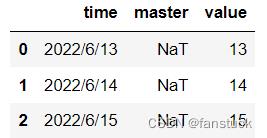
将errors设置为‘ignore’时:
df_time=pd.DataFrame('time':['2022/6/13','2022/6/14','2022/6/15'],
'master':['桃花','哈士奇','派大星'],
'value':[13,14,15])
df_time['master']=pd.to_datetime(df_time['master'],errors='ignore')不会报错,不改动:
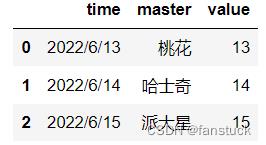
3.dayfirst
接受类型:{bool,默认为False
如果arg是str或相似的列表类型,需要指定日期分析顺序。如果为True,则首先解析日期,例如,“2012年11月10日”被解析为2012年11月10日。
df_time=pd.DataFrame('time':['13/6/2022','14/6/2022','15/6/2022'],
'master':['桃花','哈士奇','派大星'],
'value':[13,14,15])
df_time['time']=pd.to_datetime(df_time['time'],dayfirst=True)
df_time 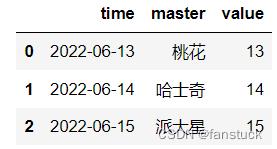
如果我们传入的日期超过了31天,则将给予警告:
ParserError: day is out of range for month: 32/6/2022
4.yearfirst
接受类型:{bool,默认为False
如果arg是str或相似的列表类型,需要指定日期分析顺序。
如果为True,则将日期解析为第一年,例如,“2012年11月10日”解析为2010年11月12日。
如果dayfirst和yearfirst都为True,则在yearfirst优先(与dateutil相同)。yearfirst=True不严格,但更倾向于使用yearfirst进行分析。
df_time=pd.DataFrame('time':['13/6/22','14/6/22','15/6/22'],
'master':['桃花','哈士奇','派大星'],
'value':[13,14,15])
df_time['time']=pd.to_datetime(df_time['time'],yearfirst=True) 
5.utc
接受类型:bool,默认为None
该参数控制与时区相关的解析、本地化和转换。
utc为时间协调时,又称世界统一时间、世界标准时间、国际协调时间。由于英文(CUT)和法文(TUC)的缩写不同,作为妥协,简称UTC。协调世界时是以原子时秒长为基础,在时刻上尽量接近于世界时的一种时间计量系统。中国大陆采用ISO 8601-1988的《数据元和交换格式信息交换日期和时间表示法》(GB/T 7408-1994)称之为国际协调时间,代替原来的GB/T 7408-1994;中国台湾采用CNS 7648的《资料元及交换格式–资讯交换–日期及时间的表示法》,称之为世界统一时间。
- 如果为True,则函数始终返回时区感知的UTC本地化时间戳、序列或DatetimeIndex。为此,时区原始输入被本地化为UTC,而时区感知输入被转换为UTC。
- 如果为False(默认),输入将不会强制为UTC。时区原始输入将保持原始,而时区感知输入将保持其时间偏移。混合偏移(通常为夏令时)存在限制,有关详细信息,请参见示例部分。
df_time['time']=pd.to_datetime(df_time['time'],utc=True) 
df_time['time']=pd.to_datetime(df_time['time'],utc=False) 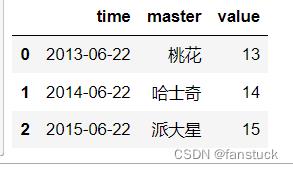
关于更多可以了解 Time zone handling
6.format
接受类型:{str}默认default None
解析时间的strftime,例如%d/%m/%Y”。请注意,“%f”将一直解析到纳秒。有关选项的更多信息,请参阅strftime文档。strftime时间字符:

df_time=pd.DataFrame('time':['2013/6/22','2014/6/22','2015/6/22'],
'master':['桃花','哈士奇','派大星'],
'value':[13,14,15])
df_time['time']=pd.to_datetime(df_time['time'],format='%Y/%m/%d')
这里会把时间统一 换成yyyy-mm-dd的形式,等于说是限定死了time的格式,不对的格式将直接报错。
7.exact
接受类型:{bool}默认default None
控制格式的使用方式:
- 如果为True,则需要精确的格式匹配。
- 如果为False,则允许格式与目标字符串中的任何位置匹配。
df_time=pd.DataFrame('time':['2013/6/22','2014/6/22','2015/6/22'],
'master':['桃花','哈士奇','派大星'],
'value':[13,14,15])
df_time['time']=pd.to_datetime(df_time['time'],format='%Y/%d/%m',exact=False)
df_time 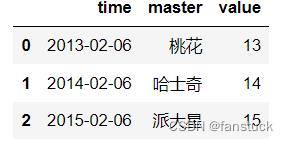
如果为True则报错:
ValueError: unconverted data remains: 2
8.unit
接受类型:{str}默认 default ‘ns’
arg的单位(D、s、ms、us、ns)表示该单位,它是一个整数或浮点数。这将基于原点。例如,使用unit='ms'和origin='unix'(默认值),这将计算到unix epoch开始的毫秒数。
像我们传入的这些yyyy-mm-dd的类型是不行的,这个解析的是时间戳的形式:
df_time=pd.DataFrame('time':['14524','14525','42512'],
'master':['桃花','哈士奇','派大星'],
'value':[13,14,15])
df_time['time']=pd.to_datetime(df_time['time'],unit='ms') 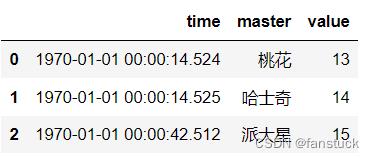
该计算开始日期为1970-01-01 00:00:00,可以通过origin来调整。
df_time=pd.DataFrame('time':['14524','14525','42512'],
'master':['桃花','哈士奇','派大星'],
'value':[13,14,15])
df_time['time']=pd.to_datetime(df_time['time'],unit='d')调整unit的参数可以让函数识别传入时间的值:
df_time=pd.DataFrame('time':['14524','14525','42512'],
'master':['桃花','哈士奇','派大星'],
'value':[13,14,15])
df_time['time']=pd.to_datetime(df_time['time'],unit='d') 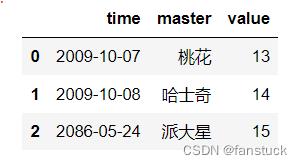
9.infer_datetime_format
接受类型:{bool}默认default False
如果为True且未给出格式,则尝试根据第一个非NaN元素推断datetime字符串的格式,如果可以推断,可切换到更快的解析方法。在某些情况下,这可以将解析速度提高约5-10倍。
如果给出的时间序列是固定的,则建议把这个参数调整为True可以加快检索速度。
10.origin
接受类型:{scalar},默认 default ‘unix’
定义参考日期。数值将被解析为自该参考日期以来的单位数(由单位定义)。
- 如果“unix”(或POSIX)时间;原点设置为1970-01-01。
- 若为“julian”,单位必须为“D”,原点设置为Julian Calendar的开始。公元前4713年1月1日中午开始的一天被指定为第0天。
- 如果时间戳是可转换的,则原点设置为由原点标识的时间戳。
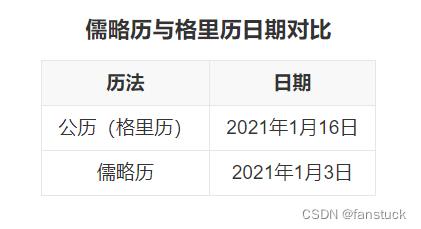
11.cache
接受类型:{bool}默认default True
如果为True,使用唯一的已转换日期缓存来应用日期时间转换。在分析重复的日期字符串时,尤其是带有时区偏移的日期字符串时,可能会产生显著的加速。仅当至少有50个值时才使用缓存。存在越界值将导致缓存不可用,并可能会减慢解析速度。
三、返回类型
1.datetime
如果分析成功。返回类型取决于输入(括号中的类型对应于时区分析失败或时间戳分析超出范围时的回退)
- 标量:时间戳(或datetime.datetime)
- 类似数组:DatetimeIndex(或对象数据类型包含datetime.datetime的系列)
- 系列:datetime64数据类型系列(或包含datetime.datetime的对象数据类型系列)
- DataFrame:datetime64数据类型系列(或包含datetime.datetime的对象数据类型系列)
2.raises
ParserError
从字符串分析日期时失败。
ValueError
当另一个日期时间转换错误发生时。例如,数据帧中缺少“年”、“月”、“日”列之一,或者时区感知日期时间。datetime位于类似混合时间偏移的数组中,utc=False。
- scalars可以是int、float、str、datetime对象(来自stdlib datetime模块或numpy)。如果可能,它们将转换为时间戳,否则将转换为日期时间。日期时间。None/NaN/null标量转换为NaT。
- array-like可以包含int、float、str、datetime对象。如果可能,它们将转换为DatetimeIndex,否则将转换为包含datetime的对象dtype索引。日期时间。在这两种情况下,None/NaN/null条目都转换为NaT。
- series将转换为datetime64数据类型的系列,否则将转换为包含datetime的对象数据类型的系列。日期时间。在这两种情况下,None/NaN/null条目都转换为NaT。
- DataFrame/dict-like:转换为datetime64数据类型的系列。对于每一行,通过组合各种数据框列创建一个日期时间。列键可以是常见的缩写,['year','month','day','minute','second','ms','us','ns')或相同的复数形式。
点关注,防走丢,如有纰漏之处,请留言指教,非常感谢
以上就是本期全部内容。我是fanstuck ,有问题大家随时留言讨论 ,我们下期见
以上是关于MySQL数据库基础:JSON函数各类操作一文详解的主要内容,如果未能解决你的问题,请参考以下文章
Pandas数据分析:处理文本数据(str/object)各类操作+代码一文详解
Pandas中to_datetime()转换时间序列函数一文详解